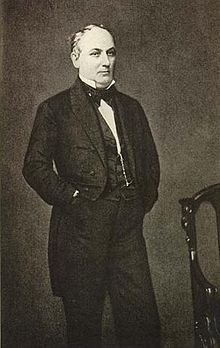James H. Hammond
| James Henry Hammond | |
|---|---|
 |
|
|
United States Senator from South Carolina |
|
|
In office December 7, 1857 – November 11, 1860 |
|
| Preceded by | Andrew P. Butler |
| Succeeded by |
Frederick A. Sawyer (1868) |
| 60th Governor of South Carolina | |
|
In office December 8, 1842 – December 7, 1844 |
|
| Lieutenant | Isaac Donnom Witherspoon |
| Preceded by | John Peter Richardson II |
| Succeeded by | William Aiken, Jr. |
| Member of the U.S. House of Representatives from South Carolina's 4th district |
|
|
In office March 4, 1835 – February 26, 1836 |
|
| Preceded by | John M. Felder |
| Succeeded by | Franklin H. Elmore |
| Personal details | |
| Born |
November 15, 1807 Newberry County, South Carolina |
| Died | November 13, 1864 (aged 56) Beech Island, South Carolina |
| Political party | Democratic, Nullifier |
| Spouse(s) | Catherine E. Fitzsimmons |
| Profession | Politician, Lawyer, Publisher, Teacher |
James Henry Hammond (November 15, 1807 – November 13, 1864) was an attorney, politician and planter from South Carolina. He served as a United States Representative from 1835 to 1836, the 60th Governor of South Carolina from 1842 to 1844, and United States Senator from 1857 to 1860. He was considered one of the major spokesmen in favor of slavery in the years before the American Civil War.
Acquiring property through marriage, he ultimately owned 22 square miles, several plantations and houses, and more than 300 slaves. Through his wife's family, he was a brother-in-law of Wade Hampton II and uncle to his children, including Wade Hampton III. When the senior Hampton learned that Hammond had abused his four Hampton nieces as teenagers, he made the scandal public. It was thought to derail Hammond's career for a time, but he was later elected as US senator. The Hampton family suffered more, as none of the girls married.
Hammond graduated from South Carolina College in 1825, going on to teach school, write for a newspaper and study law. He was admitted to the bar in 1828 and started a practice in Columbia, South Carolina. He established a newspaper there in support of nullification.
Hammond "secured his financial independence" by marrying Catherine Elizabeth Fitzsimmons, who was a shy, plain 17-year-old with a substantial dowry. He became a wealthy man through this marriage and entered the planter class. He ultimately owned 22 square miles, a number of plantation houses, and more than 300 slaves.
...
Wikipedia
